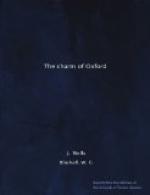[Plate III. View of Radcliffe Square]
The visitor to Oxford often asks—“Where is the University?” The proper answer is: “The University is everywhere,” for the colleges are all parts of it. But if a distinction must be made, and some buildings must be shown which are especially “University Buildings,” then it is undoubtedly in the Square, of which this picture shows one side, that they must be found. Immediately on the right is the Bodleian Library, the domed building in the centre is the Radcliffe Library, and in the background rises the spire of St. Mary’s. Of this last building the tower and spire go back nearly to the beginnings of Oxford; they date from the time of Edward I; but for a century, at least, before they were erected, the students of Oxford had met for worship and for business in the earlier church, which stood on the site of the present St. Mary’s.
The Bodleian Library occupies the old Examination Schools, which were built, in the reign of James I, for the reformed University of Archbishop Laud; within the memory of men who do not count themselves old, the university examinations were still held in this building. Finally, the shapely dome between the Bodleian and St. Mary’s is the work of James Gibbs, the greatest English architect of the eighteenth century, to whom Cambridge owes its Senate House, and London the noble church of St. Martin’s in the Fields. The dome was built for a separate library, the foundation of Dr. John Radcliffe, Queen Anne’s physician, the most munificent of Oxford benefactors; it is still managed by his trustees, a body independent of the University, but since 1861 they have lent it to the Bodleian Library for a reading-room. It is fitting that the oldest public library in the modern world, a title the Bodleian can proudly claim, should have the finest reading-room, where 400 students can have each his separate desk, and where, if so minded and so physically enduring, they can put in twelve hours’ work in a day. No other great library in Europe allows such privileges.
Round these three University buildings are grouped three colleges: Hertford, the youngest of Oxford foundations, the re-creation of an old hall by a Victorian financial magnate. Sir Thomas Baring; All Souls’, standing a little beyond, of which the part here shown is the corner of the great Law Library, founded by Sir William Codrington in the days of good Queen Anne; while on the other side of the Radcliffe is Brasenose College (for pictures of which see Plates II and XV). No non-academic building fronts on the Square; the one or two houses facing on the south-west corner are occupied by college tutors. The academic influence has spread even under the earth, for between the Bodleian and the Radcliffe there is a great subterranean chamber of two stories, excavated 1909-1910, which, when full, will contain 1,000,000 books.




